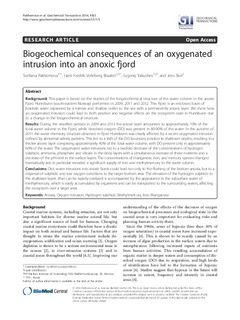| dc.contributor.author | Pakhomova, Svetlana | |
| dc.contributor.author | Braaten, Hans Fredrik Veiteberg | |
| dc.contributor.author | Yakushev, Evgeny | |
| dc.contributor.author | Skei, Jens | |
| dc.date.accessioned | 2014-11-21T14:18:50Z | |
| dc.date.accessioned | 2014-11-24T13:54:05Z | |
| dc.date.available | 2014-11-21T14:18:50Z | |
| dc.date.available | 2014-11-24T13:54:05Z | |
| dc.date.issued | 2014 | |
| dc.identifier.citation | Pakhomova, S., et al., 2014. Biogeochemical consequences of an oxygenated intrusion into an anoxic fjord. Geochemical Transactions 15(1) 5 | nb_NO |
| dc.identifier.issn | 1467-4866 | |
| dc.identifier.uri | http://hdl.handle.net/11250/226386 | |
| dc.description.abstract | Background: This paper is based on the studies of the biogeochemical structure of the water column in the anoxic Fjord Hunnbunn (south-eastern Norway) performed in 2009, 2011 and 2012. This Fjord is an enclosed basin of brackish water separated by a narrow and shallow outlet to the sea with a permanently anoxic layer. We show how an oxygenated intrusion could lead to both positive and negative effects on the ecosystem state in Hunnbunn due to a change in the biogeochemical structure. Results: During the stratified periods in 2009 and 2012 the anoxic layer amounted to approximately 10% of the total water volume in the Fjord, while dissolved oxygen (DO) was present in 80-90% of the water. In the autumn of 2011 the water chemistry structure observed in Fjord Hunnbunn was clearly affected by a recent oxygenated intrusion defined by abnormal salinity patterns. This led to a shift of the DO boundary position to shallower depths, resulting in a thicker anoxic layer comprising approximately 40% of the total water volume, with DO present only in approximately 60% of the water. The oxygenated water intrusions led to a twofold decrease of the concentrations of hydrogen sulphide, ammonia, phosphate and silicate in the deep layers with a simultaneous increase of these nutrients and a decrease of the pH level in the surface layers. The concentrations of manganese, iron, and mercury species changed dramatically and in particular revealed a significant supply of iron and methylmercury to the water column. Conclusions: Oxic water intrusions into anoxic fjords could lead not only to the lushing of the bottom anoxia, but to a dispersal of sulphidic and low oxygen conditions to the larger bottom area. The elevation of the hydrogen sulphide to the shallower layers (that can be rapidly oxidized) is accompanied by the appearance in the subsurface water of methylmercury, which is easily accumulated by organisms and can be transported to the surrounding waters, affecting the ecosystem over a larger area. | nb_NO |
| dc.language.iso | eng | nb_NO |
| dc.publisher | Biomed | nb_NO |
| dc.relation.uri | http://www.geochemicaltransactions.com/content/pdf/1467-4866-15-5.pdf | |
| dc.rights | Creative Commons Attribution License | * |
| dc.rights.uri | http://creativecommons.org/publicdomain/zero/1.0/ | * |
| dc.rights.uri | http://creativecommons.org/publicdomain/zero/1.0/ | |
| dc.title | Biogeochemical consequences of an oxygenated intrusion into an anoxic fjord | nb_NO |
| dc.type | Journal article | nb_NO |
| dc.type | Peer reviewed | nb_NO |
| dc.date.updated | 2014-11-21T14:19:00Z | |
| dc.rights.holder | © 2014 Pakhomova et al | |
| dc.subject.nsi | VDP::Mathematics and natural science: 400 | nb_NO |
| dc.source.journal | Geochemical Transactions | nb_NO |
| dc.identifier.doi | 10.1186/1467-4866-15-5 | |
| dc.identifier.cristin | 1162545 | |
| dc.rights.license | Creative Commons Attribution License | |

